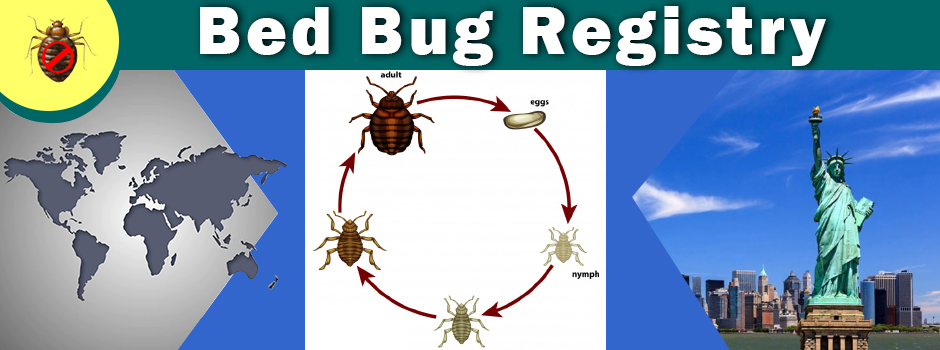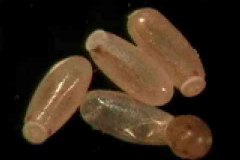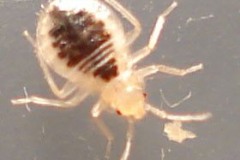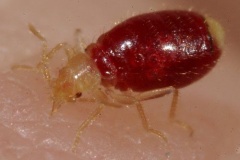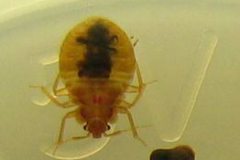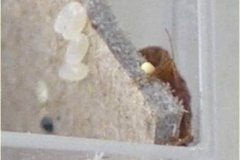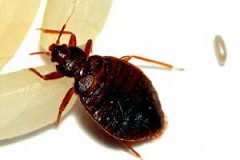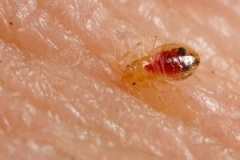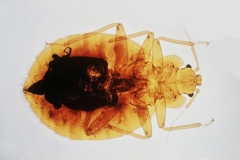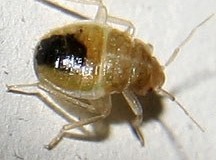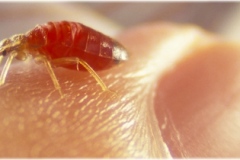Killing Bed Bugs is Hard Work, both Mentally and Physically
Bed bugs are hard to exterminate because the treatment process, which begins with a thorough inspection, is more complicated than for most other insects. Every step, from start to finish, requires skills honed to a degree unmatched in any other field of pest management. Those skills come from training and experience, and must be backed up with effective treatment methods, specialized treatment equipment, sophisticated protective clothing, and personal commitment.
So, mentally, those engaged in bed bug inspections and treatments must be at the top of their class. To the surprise of many, the same also applies to the physical demands of this work. A bed bug inspector who does nothing beyond pulling back the bed clothes, shining a flashlight into a few dark corners, and looking under the bed and at the baseboards, isnt worthy of the title. Real bed bug inspectors sweat. Real bed bug inspections are among the most physically demanding jobs known in the pest management business.
To conduct a valid bed bug inspection the inspector must lift and closely examine every surface, seam, and crevice of the largest, heaviest, most unwieldy mattresses and box springs manufactured. While doing that, the inspector must make sure nothing besides the inspectors gloves contacts the mattress, box springs, or bed frame. Sloppy inspectors contaminate themselves with bugs and eggs while inspecting. Later they carry bed bug infestations from one inspection to the next, as well as to all the places they visit in between, including their offices, their homes, and the places where they shop. Thats not conducive to good public relations.
And the Risks are High, Too
Imagine youre a bed bug inspector/exterminator, standing in line at a coffee shop, when the customer next to you says, in a very loud voice: Hey, is that a bed bug on your sleeve? Youre an exterminator, right? Did you just come from a place infested with bed bugs? The manager of the coffee shop overhears, comes over, sees the bug the customer is pointing to and ushers you out of the shop. There the manager pauses to write down your name and the name of your company. Now imagine, a week or two later, getting a call from that manager informing you the coffee shop has become infested with the bed bugs that you brought into the place, and asking, in an angry voice, What are you going to do about it?
Get the point? If you are a homeowner doing a bed bug inspection in your own bedroom, the same cautions apply to you, as well. Every surface of those articles of furniture, and of any associated bed frames, headboards, footboards, sofas, divans, dressers, etc., must be examined closely from every visible angle, without getting a single bed bug on your clothing in the process. That means lifting mattresses and box springs off the bed and carefully turning them successively through 360 degrees of rotation, all the while peeling back, illuminating, and inspecting every seam, every crack, and every crevice to avoid missing the small, isolated and well-hidden groupings of bed bugs typically present with fresh infestations. The bed frame must then be dismantled it is impossible to inspect the cracks where the pieces mate unless you take everything apart and examined with the same care, as must the remaining articles of furniture in the area suspected of being infested.
An inspector unwilling or incapable of safely and carefully performing such physically demanding work cannot claim to perform effective bed bug inspections. Thats important, because the results of poorly performed inspections are costly, for everybody.
Bed bug treatments require similar, if not more strenuous bouts of sheer physical exertion as inspections. When I finish either a bed bug inspection or a full treatment Im usually soaked in perspiration even in the midst of winter and look like Ive just run a marathon. For that reason, I dress for the job year-round as though preparing for a long hike up a mountain trail, with mountaineer-tested polyester undershirts and shorts that wick enough of the perspiration away so I dont look like a drowned rat when Im done.
-
Call EntomoBiotics Inc. at: (512) 331-1111 forquestions about, or help with, your or your customers bed bug issues.
-
Training Never Ends
The typical telephone call about bed bugs starts with Hi, I have bed bugs. Do you treat for them? The first question I ask the caller is Are you sure you have bed bugs? Much of the time the caller answers with Yes, Im 100% sure. My doctor says my bites are from bed bugs or Ive seen the bugs, and they look exactly like the ones I found on the Internet.
Yet, even when the caller is 100% certain they have bed bugs, 30-40% of the time, the resulting bed bug inspection finds zero bed bugs and no visible evidence of their presence.
Granted, on rare occasions bed bugs are actually present but cannot be found even after conducting a thorough, well-done inspection. Most of the time, though, when a thorough inspection fails to find bed bugs, something else besides bed bugs is causing the sufferers skin lesions or showing up on or in the bed.Im often presented with specimens of bugs collected by homeowners from their beds and bedrooms. Most are 100% certain the specimens are bed bugs, yet on examination they turn out to be something else entirely. But thats no reflection on the homeowners; insect identification is not quite as simple as it looks.
Not all Skin Lesions are Caused by Bed Bugs
As pointed out later in this article, it is difficult to impossible to identify the cause of a skin lesion just by examining the outward features of the lesion. Patterns of lesions on a persons body dont provide conclusive evidence of the cause, either.Skin lesions that look like bed bug bites can be, and often are, caused by a number of other agents or organisms. It is important to get to the bottom of the actual cause. Just knowing how to identify bed bugs is not enough.
Successful bed bug inspectors must be skilled, not only in finding and identifying bed bugs, but also at finding and identifying practically all the non-bed-bug organisms and agents that may also cause human skin lesions. That, alone, requires a depth and breadth of knowledge, training, experience, and commitment that goes far beyond that needed solely to inspect for and treat bed bugs.
Many companies ignore this and assign inexperienced, poorly trained personnel to perform bed bug inspections and treatments. Others assign personnel to this work whose training and experience appears adequate but whose level of personal commitment is below par. The inspector must be operating at 100% efficiency, mentally and physically, at every inspection. Cutting corners, taking it easy just once out of 100 inspections can spell disaster. Whenever a bed bug inspection or treatment is performed, the individual who signs off on the work must be ready, willing, and able to take full responsibility for following through and ensuring the client is fully satisfied with the result.
Why Many Pest Managers Dont Inspect for or Treat Bed Bug Infestations
Not every pest management firm is willing to subject itself or its employees to the risks that come with inspecting for and treating bed bugs. Those who opt out of that field are often the best and most reputable pest management firms around when it comes to general pest management work. They are also some of the best companies to work for, because they refuse to subject their employees to the risks and overtime commitments that typically go along with bed bug work.
Others specialize in handling pest management issues, like bed bugs, with which most companies wisely prefer not to deal. All those who do bed bug inspections and treatments discover, sooner or later, the importance of making a positive confirmation of the existence of bed bug infestations before treating. Many do not, and pay high penalties for failing to do so. Of those that do, only a few are sufficiently well-versed in finding and identifying the other organisms and agents that can produce skin lesions capable of mimicking bed bug bites. The result is thatmany pest management companies find themselves regularly treating homes for bed bugs when no bed bugs are present. For a while that may even seem like a good financial model. If 30-40% of the time no bed bugs are present, pretending they are and treating for them brings in more revenue. Until, that is, the treatment failures begin to mount up. And, trust me, they will.
As I pointed out in an earlier article, the outward manifestation of a skin lesion is often more a function of the sufferers immune system than of the actual cause of the lesion. Despite a vast array of photos on the Internet showing typical bed bug bites, the average persons skin lesions rarely fit the norm. Many so-called typical bed bug bites turn out to have been caused by something other than bed bugs. Furthermore, many of the other causes of skin lesions that mimic bed bug bites are not resolved by any of the bed bug treatments presently in use, whether the treatment involves the use of heat, steam, pesticides, green products, or any combination thereof.
Whenever new skin lesions occur after a bed bug treatment has been performed, the implication is that the treatment failed and should be re-done. Often, however as noted above there were no bed bugs to eradicate in the first place, or the treatment succeeded in eradicating them, but another undetected organism or agent is still present and fully capable of irritating the clients skin. When either situation occurs, what usually results is a succession of unsuccessful re-treatments that often read like scenes from a horror movie.
Having The Right Equipment is Crucial
It bears repeating that identifying the actual cause of skin lesions on a homes occupant or occupants iscrucial. Doing so requires the use of sophisticated detection, collection, and analysis equipment. The user must also possess extensive training and experience in how to use such equipment. Just as important, the individual who does the collecting must be able, in the field, to study the evidence collected by the equipment and accurately interpret the clues that such evidence provides. For my bed bug inspections I take advantage of almost all of the unique tools used by crime scene specialists for collecting trace forensic evidence, including vacuums and sweeps fitted with trace specimen isolators, digital microscopes, laptop computers, and specialized analytic software.
What happens if bugs are found during the inspection, and a cursory examination with a hand lens confirms that they have all the outward anatomical characters of bed bugs? Can the inspector terminate the inspection immediately and formulate a plan of treatment without further ado? Although most pest management companies do exactly that, much more must yet be done, after bed bugs are confirmed, before a bed bug inspection is complete.
Got Bed Bugs? And What Else?
In truth, bed bug inspections should really be called skin lesion precursor inspections. Sometimes the causes of a persons skin lesions are strictly bed bugs. At other times, the lesions may be caused by another organism or agent altogether and bed bugs have nothing to do with it. More often than not, though, the lesions can be caused by both bed bugs and another easily overlooked organism or agent. Yes, ancillary causes of skin lesions may exist alongside the presence of bed bugs, too. Thats something many pest management professionals dont realize, but ignoring or neglecting it can lead to major problems later.
Many people are afflicted with one or more chronic skin conditions that produce lesions similar to bed bug bites. When bed bugs are suspected, those chronic conditions may be forgotten or discounted. Many people without chronic skin conditions becometemporarilysusceptible to skin lesions caused by other organisms or agents that normally would not affect them, but are expressedduring periodswhen they re subjected to excessive levels of stress. The psychological effect of having to deal with bed bugs is unusually high on the list of human stressors. Coping with such levels of stress often makes one or more of the occupants of a home more susceptible to ancillary causes of skin lesions. Most companies fail to consider the possibility that some of the skin lesions are stress related. That prevents them from taking the time to inspect for possible ancillary causes and identify their presence. Neglecting to deal with such conditions properly is a major cause of what appear to be treatment failures when, in fact, the bed bugs have been controlled but the ancillary issues have not been handled.
Birds, Bats, and Other Causes of Bed Bugs
Even when bed bugs are confirmed to be present, the real cause of the bed bug infestation may not be apparent. Those who assume that bed bugs arebeingbrought in solely by the human occupants of the home are often mistaken, which is why every bed bug infestation must first be examined under the microscope before a treatment plan is formulated.
Over 70 species, in 22 genera, are recognized in the Cimicidae family (the family of insects comprising bed bugs and their kin) worldwide. Most of them are typically found associated with warm blooded animals other than humans, but nearly all are capable of parasitizing human hosts when their typical hosts are absent. Not only that, but nearly all of those are just as transportable, in luggage and other personal effects, by travelers who fly, ride trains and busses, rent automobiles, and sit in waiting rooms at hospitals, medical clinics, and you name it Many people living in Central Texas regularly travel outside the United States, and some of them unwittingly bring back some of the bed bugs they encounter along the way.
Native bed bugs, commonly found throughout the U.S. in general, also include a multitude of species. Birds and bats roosting in a homes attic, eaves, or walls, will often bring bird bugs or bat bugs in with them. Other animals, too, can host cimicid parasites that when their animal hosts are not present will leave the nest and go looking for the closest warm body available. Under magnification the subtle anatomical characters that distinguish non-typical bed bugs from common bed bugs can alert the professional when an atypical infestation of this nature has been found. However, few bed bug inspectors have the knowledge or skills necessary to make such distinctions.
Excluding such Animals is Not Enough
Treatment of cimicid infestations emanating from animal nests must go way beyond treating the secondarily-infested areas inside the occupied portions of a home. If the birds, bats, and other animals that brought the bugs to the home are not dealt with, the bugs will show up again, no matter how well the treatment inside the occupied portions of the home, is done.
Bird, bat, and animal exclusion processes alone, however, will not resolve the infestation if the nesting materials which provide a reservoir of bugs waiting to resurface inside the home are not treated. Bird nests and bat roosts in attics are often extensive. Besides repairing the ingress/egress access ports used by the offending animal, so that future nesting is brought to a halt, existing nesting materials must be disinfected and treated to eradicate existing parasites that must be suspected of harboring not only cimicids but parasitic mites as well.
The Importance of Proper Personal Protective Equipment
In addition to all the complications attending bed bug inspections and treatments mentioned above, the inspector and those performing bed bug treatments must be properly garbed when dealing with any organism or agent suspected of causing skin lesions. Like everything else involving bed bugs, thats easier said than done, but the penalties for failing to wear the right protective gear at the right time, and for failing to remove and dispose of that gear properly, are sobering. Not only does an improperly garbed individual risk being personally contaminated, but everyone who comes into contact with that individual risks becoming contaminated as well.
The fastest way to decide never, ever, to do another bed bug inspection or treatment again is to discover, belatedly, that youve brought bed bugs to your home, or that youve unwittingly passed them on to one of your clients, or to your favorite coffee shop. Imagine walking into a clients office and having someone in your clients employ peer closely at your shoulder, saying Gee, is that a bed bug on your shirt? And didnt you tell me you were coming here from a home you were treating for bed bugs? Talk about a recipe for disaster Imagine, two weeks later, getting a call from that same client saying Remember the bed bug John noticed on your shirt when you were here last? Well, now we have bed bugs in my office. I need you to come out here right now. Dont even think of charging that client for the treatment you will now be forced to carry out for free. And dont be surprised when every employee of that company suddenly has bed bugs in their homes that they also expect you to treat for free.
Mandatory protective clothing for bed bug inspections and treatments include heavy-duty 6 mil. disposable gloves with extended gauntlets, wide-brimmed headgear or, when wearing a full-face mask, a disposable bonnet, plus an ascot to protect the neck, back, and chest from falling bugs that might otherwise fall down inside your shirt, and disposable foot-to-knee cleanroom footwear. These articles of clothing should be donned immediately on arrival at the inspection and/or treatment site, before work commences, for all present to see. During the inspection and/or treatment, it is crucial that sterile, non-contact procedures be followed as closely as possible and that all articles of clothing worn by the inspector/exterminator be treated to deal with bed bugs and eggs that may inadvertently fall onto them while the job is being done. When manipulating mattress, box springs, or any piece of furniture that may harbor bed bugs, inadvertent contact must immediately be followed by an inspection of the personal area where contact was made to ensure no contamination occurred, and to enable the inspector to remove any contamination that is observed at once.
These precautions and procedures reduce the risk of contamination, but they are not foolproof, and they are easily defeated during removal of the protective articles when the job is complete. Remember the problems the nurses treating Ebola patients experienced? Similar issues surround treatments for bed bugs. Before removing disposable protective articles of clothing a complete inspection of ones person must be conducted to make sure no hitchhikers are marching around on shirts, trousers, sleeves, etc. All disposable articles of clothing must be disposed of on site, upon exiting, to ensure no hitchhiking organisms are taken away unwittingly.
-
This article is still under construction. As it unfolds actual case histories of good and bad bed bug treatments will be described that demonstrate the importance of having a positive work attitude, and an abiding interest in the customers health and welfare. Pest managers who treat for bed bugs, in particular, have to care deeply about their customers. How deeply? Its hard to place a limit on it. But its impossible to care without first having a positive attitude. Positivity is the cement that holds a good job together. Negativity, on the other hand, makes what should have been a good job fall completely apart, even when the technician is well-trained, and is provided with the best equipment and pesticides on the market.
Ill explain the details as we go along
-
Questions? Comments? Corrections? e-mailjerry.cates@bugsinthenews.info.
You may also register, log in, and leave a detailed comment in the space provided below.
This article by Jerry Cates was first published on 27 October 2014, and last revised on 12 December 2014. Bugsinthenews Vol. 15:10(01)
-
Abstract:The author, a specialist in bed bug inspections and treatments in the Austin, Texas metropolitan area, reports on the extraordinary difficulties attending bed bug diagnosis and remediation. No insect is more difficult than the common bed bug, and few jobs are nastier or carry more risks than identifying and eradicating them. It is impossible to do either without investing in expensive gear and pesticides vetted and labeled specifically for bed bugs. Yet those prerequisites are useless until combined with specialized knowledge and years of practical experience. Over the years the author has had to investigate for and clean up after a lot of botched bed bug jobs, most done by homeowners, but some done by professionals in the pest management business. In so doing hes noticed several mistakes common to all.
Like Loading...
Read the rest here:
Bad Bed Bugs in Austin, Texas: Why theyre so Hard to ...

 Residence
Residence  Location
Location 
